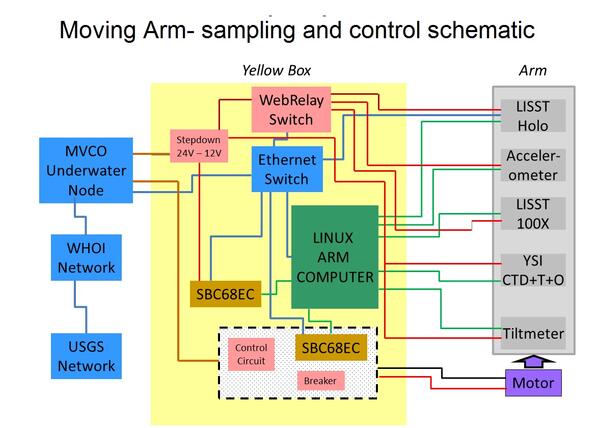Brian Buczkowski of the USGS Woods Hole Coastal and Marine Science Center uses a benchtop spectrometer to measure carbonate ion (CO32−) concentration in a seawater sample during the 7-week 2011 research cruise in the Arctic Ocean aboard the U.S. Coast Guard Cutter Healy. USGS photograph by Lisa Robbins.
Images
Woods Hole Coastal and Marine Science Center images
Brian Buczkowski of the USGS Woods Hole Coastal and Marine Science Center uses a benchtop spectrometer to measure carbonate ion (CO32−) concentration in a seawater sample during the 7-week 2011 research cruise in the Arctic Ocean aboard the U.S. Coast Guard Cutter Healy. USGS photograph by Lisa Robbins.
Map C. Backscatter intensity and sun-illuminated topography. Blue= "soft" seabed, Green, orange = "hard" seabed
Map C. Backscatter intensity and sun-illuminated topography. Blue= "soft" seabed, Green, orange = "hard" seabed

Stellwagen Bank project research areas in the United States and Canada
Stellwagen Bank project research areas in the United States and Canada
Cape Hatteras, N.C.
Map of Fire Island, N.Y. study area
Map of Fire Island, N.Y. study area
Map of Long Bay, S.C. study area
Study area map of coastal South Carolina
Study area map of coastal South Carolina
Oceanographic equipment recovery
Map showing Holocene (modern) sediment thickness in meters overlain on bathymetry. Regional bathymetric contours are in meters. Note the shoreface-attached sand ridges west of Watch Hill.
Map showing Holocene (modern) sediment thickness in meters overlain on bathymetry. Regional bathymetric contours are in meters. Note the shoreface-attached sand ridges west of Watch Hill.

Map showing the thickness of a relatively young Pleistocene outwash lobe in meters mapped using chirp seismic-reflection profiles collected in 2011, overlain on acoustic backscatter imagery. Regional bathymetric contours are in meters.
Map showing the thickness of a relatively young Pleistocene outwash lobe in meters mapped using chirp seismic-reflection profiles collected in 2011, overlain on acoustic backscatter imagery. Regional bathymetric contours are in meters.
Numerical model grids showing downscaling from larger regional grid (far right) to more refined coastal grid (left). Colors are bathymetry (m).
Numerical model grids showing downscaling from larger regional grid (far right) to more refined coastal grid (left). Colors are bathymetry (m).
Deployment period storm analysis. (A) significant wave height (red line) and wind speed and direction (arrows). Shading represents storm type (blue = cold front, red = warm front, yellow = low-pressure). (B) Vertical profiles of suspended-sediment concentration. (C) Cumulative along-shore and cross-shore sediment flux.
Deployment period storm analysis. (A) significant wave height (red line) and wind speed and direction (arrows). Shading represents storm type (blue = cold front, red = warm front, yellow = low-pressure). (B) Vertical profiles of suspended-sediment concentration. (C) Cumulative along-shore and cross-shore sediment flux.
Example of a rip current experiment. Colors show bathymetry and arrows show velocity vectors after 1 h of model simulation. Similar to results in Kumar and others, 2012.
Example of a rip current experiment. Colors show bathymetry and arrows show velocity vectors after 1 h of model simulation. Similar to results in Kumar and others, 2012.

Schematic of system designed to control movement and logging of data collected by the Moving Arm Tripod at Martha's Vineyard Coastal Observatory in 2011.
Schematic of system designed to control movement and logging of data collected by the Moving Arm Tripod at Martha's Vineyard Coastal Observatory in 2011.

Bathymetry of the New England inner shelf and south shore of Martha’s Vineyard with model grids
Bathymetry of the New England inner shelf and south shore of Martha’s Vineyard with model grids

Worldwide distribution of observed and inferred gas hydrates in marine and permafrost-associated settings that have been the subject of drilling programs. The color coding refers to the primary sediment type in each location and therefore designates the likely type of gas hydrate reservoir at each site.
Worldwide distribution of observed and inferred gas hydrates in marine and permafrost-associated settings that have been the subject of drilling programs. The color coding refers to the primary sediment type in each location and therefore designates the likely type of gas hydrate reservoir at each site.

Steaming to the deployment site south of Martha's Vineyard, MA in 2011. The platform shown was specially adapted so the arm cycles up and down through the Benthic Boubdary Layer while deployed on the seafloor. For more information see https://soundwaves.usgs.gov/2011/11/fieldwork2.html.
Steaming to the deployment site south of Martha's Vineyard, MA in 2011. The platform shown was specially adapted so the arm cycles up and down through the Benthic Boubdary Layer while deployed on the seafloor. For more information see https://soundwaves.usgs.gov/2011/11/fieldwork2.html.
Nice photo-op of Healy with a striking background.
Nice photo-op of Healy with a striking background.
Ice conditions in the Arctic from CCGS Louis S. St-Laurent.
Ice conditions in the Arctic from CCGS Louis S. St-Laurent.

It is very unusual for large (400 ft) vessels to be so close together during normal science operations. In this case, the skilled ship handling of the Captain from USCGC Healy enabled Healy to back within ~75 ft of Louis to clear ice around the bow of Louis, thereby releasing pressure and allowing her to move again.
It is very unusual for large (400 ft) vessels to be so close together during normal science operations. In this case, the skilled ship handling of the Captain from USCGC Healy enabled Healy to back within ~75 ft of Louis to clear ice around the bow of Louis, thereby releasing pressure and allowing her to move again.















